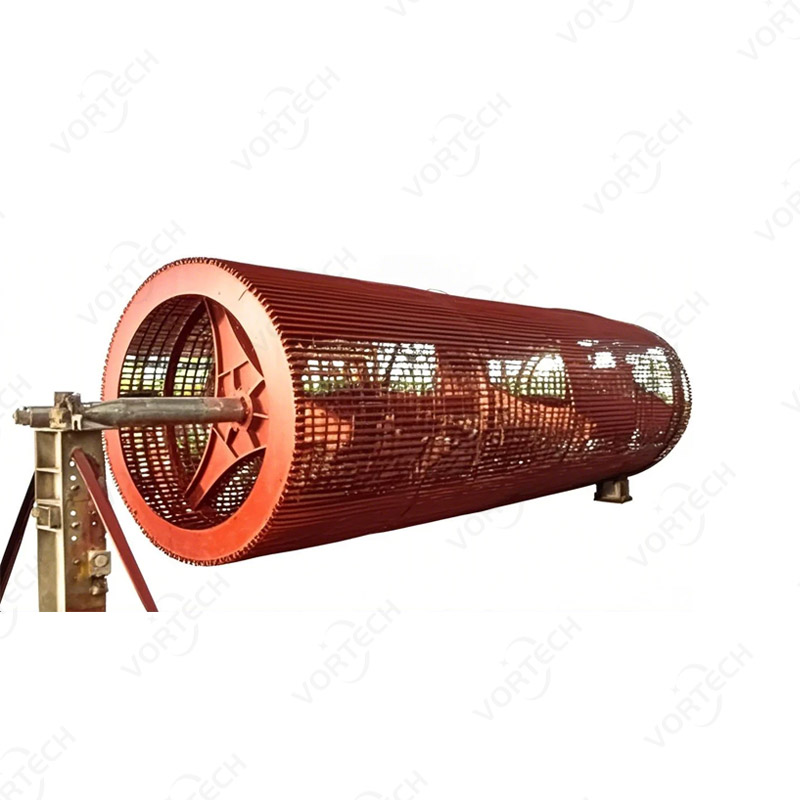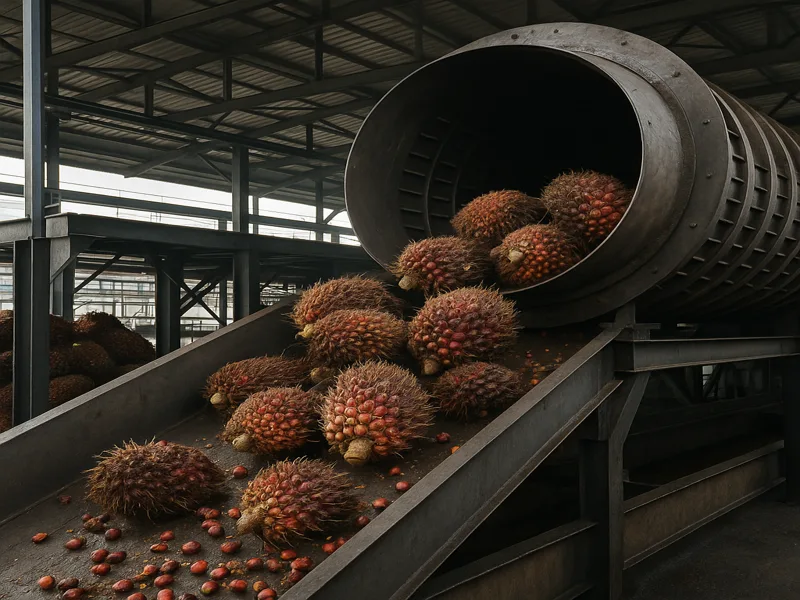Palm oil extraction relies on specialized machinery, with the thresher drum—also known as the fruit bunch stripper—playing a crucial role in separating oil-rich fruits from fresh fruit bunches (FFBs). Though often overshadowed by larger equipment, its function is essential for effective extraction and high yield. This article explores its mechanics, role, and key maintenance practices.
Overview of the Palm Oil Extraction Process
Before examining the thresher drum in detail, it’s important to understand where it fits into the broader palm oil processing equipment. The typical flow in a palm oil mill includes:
- Reception of FFB (Fresh Fruit Bunches)
- Sterilization – Steam treatment to inactivate enzymes and loosen fruits
- Threshing – Separation of fruits from the bunches (Thresher drum stage)
- Digestion – Mashing of fruits to release oil
- Pressing – Extraction of crude palm oil (CPO)
- Clarification and Purification
- Kernel recovery from nuts
- Waste handling and fiber recycling
As the third stage in this chain, threshing sets the tone for downstream processing. Incomplete fruit removal or excessive damage at this point can affect oil quality, increase kernel loss, and reduce efficiency in the digester and press.

What is a Thresher Drum?
The thresher drum is a cylindrical rotating machine designed to mechanically detach individual palm fruits from the sterilized bunches. Inside the drum, lifters or blades attached to the internal walls create agitation. As the drum rotates, the movement, impact, and friction between the bunches and the lifters strip the fruits away, allowing them to fall through perforations while the empty bunches (EFB) exit the opposite end.
🛠️ Basic Components of a Thresher Drum:
| Component | Function |
| Rotating Drum Cylinder | Houses FFB and creates tumbling action |
| Lifters/Blades | Agitate and dislodge fruits from the bunch |
| Perforated Drum Wall | Allows detached fruits to fall through |
| Drive Motor/Gearbox | Powers the rotation mechanism |
| Chute/Feeding Hopper | Introduces sterilized FFB into the drum |
| EFB Discharge End | Ejects the remaining empty bunches |
How the Thresher Drum Works
The drum’s feeding end is filled with sterile fruit bunches. As the drum rotates—usually at 20–30 RPM—the bunches tumble inside, experiencing impacts and scrubbing actions created by the lifters. The design ensures that:
- Fruits are separated cleanly and completely
- Empty bunches are discharged efficiently
- Minimal mechanical damage occurs to the fruitless
Detached fruits fall through the perforations onto a vibrating screen or conveyor below, which transports them to the digestion stage.
Importance of the Thresher Drum in Palm Oil Extraction
✅ Maximizing Oil Yield
Efficient fruit separation ensures that more fruits reach the digester, which translates into higher crude palm oil (CPO) recovery. Poor threshing leads to unstripped bunches—fruit still attached—being discarded with the EFB, resulting in oil loss.
✅ Protecting Downstream Equipment
Overloading the digester or press with large bunches of debris can damage machinery or slow processing. The thresher drum ensures that only clean, detached fruits enter the next phase.
✅ Improving Kernel Recovery
Damaged or crushed fruits during threshing can complicate nut and kernel separation later in the process. Properly threshed fruits preserve kernel integrity, enhancing palm kernel oil (PKO) recovery.
✅ Reducing Fiber and Debris Contamination
Clean separation reduces contamination of oil with fiber, stalks, or foreign matter. This improves oil clarity and lowers the burden on clarification equipment.
Factors That Influence Threshing Efficiency
Several mechanical and operational variables influence the performance of the thresher drum:
🔄 Drum Speed
- Too slow: Incomplete fruit detachment
- Too fast: Increased mechanical damage and excessive wear
- Optimal speed depends on fruit size, drum length, and internal design
🔨 Lifter Design and Wear
The shape, angle, and height of lifters affect how effectively fruits are dislodged. Worn lifters must be replaced or rebuilt to maintain performance.
🌀 Feed Rate
Overloading the drum with too many FFBs reduces tumble space, leading to inefficient separation and potential clogging.
🌡️ Fruit Ripeness and Sterilization
Under-sterilized or overripe bunches may not thresh effectively. Proper steam sterilization softens fruit stalks and aids separation.
⚙️ Drum Length and Perforation Size
Longer drums offer more agitation time. Perforation size must be matched to average fruit size—too small and fruits get stuck; too large and debris contaminates the fruit stream.
Best Practices for Thresher Drum Operation
✔️ Consistent Loading
Feed the thresher at a uniform rate to avoid overloading, which causes jamming, or underfeeding, which reduces productivity.
✔️ Routine Cleaning
Remove stuck fibers and residues daily to prevent buildup and drum imbalance.
✔️ Daily Inspection Checklist
- Check for unusual noise or vibration
- Inspect lifters for cracks or wear
- Ensure fruit and EFB discharge chutes are clear
✔️ Calibration for Different Bunch Sizes
Adjust lifter angles and drum speed during seasons when fruit size varies significantly.
✔️ Steam Leak Avoidance
Ensure no condensate enters the thresher; moisture can cause slippage and fiber clumping.
Maintenance Tips to Extend Thresher Drum Life
| Maintenance Task | Frequency | Goal |
| Lifter Bolt Tightening | Weekly | Prevent lifter movement or detachment |
| Perforation Hole Cleaning | Daily | Ensure proper fruit fall-through |
| Gearbox Lubrication | Monthly | Maintain smooth, reliable rotation |
| Bearing Inspection | Bi-monthly | Detect wear, overheating, or misalignment |
| Motor Load Monitoring | Weekly | Prevent overcurrent and mechanical overload |
| Structural Weld Checks | Quarterly | Prevent cracks from fatigue or vibration |
Typical Problems and Their Solutions
❌ Problem: Significant Fruit Loss in EFB
- Cause: Low drum speed or worn lifters
- Solution: Restore speed settings, replace worn lifters
❌ Issue: High Fiber in Fruit Discharge
- Cause: Oversized perforations or over-aggressive lifting
- Solution: Install finer screens, review lifter design
❌ Issue: Excessive Vibration or Noise
- Cause: Loose lifters, unbalanced drum, bearing failure
- Solution: Inspect mounting, rebalance drum, replace worn bearings
❌ Issue: Frequent Jamming
- Cause: Overfeeding or fibrous material blockage
- Solution: Reduce feed rate, install pre-screening
Conclusion
The thresher drum, despite its straightforward design, is essential to the production of palm oil. It ensures clean fruitlet separation, boosting oil yield and equipment life.
Proper maintenance and operation are vital for efficient, sustainable production. As automation grows, smarter thresher systems will further enhance output and reliability.


